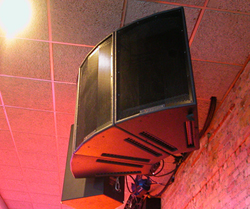
If you want smooth response you have to design for it. Failure to consider loudspeaker/boundary interactions can result in uneven frequency response, spotty coverage, poor intelligibility and over-equalized sound systems.
The bottom line? Horns are immune from boundary effects and boundary affects are one of the biggest detriments to high quality sound.
Boundary Interference Solutions
Let’s face it. There are many applications where the loudspeaker must be mounted near a boundary.
Since I had things setup anyway, I decided to try some methods often used to tame the boundary interaction.
The bookshelf loudspeaker was measured since it is often used in small-room systems. Figure 10 shows a comparison of the free-field response, one-quarter space response and treated response.
While it can be said that the treatment produced a change, I would not call it a fix.

Also, this is far more aggressive treatment than would typically be used in an actual sound system, where 1-inch mineral wool panels are sometimes used to “clean up” the boundary interference.
I thought it would be a shame to not go one step further and test an in-boundary mounting. One wall of the test room has a cut-out used for testing ceiling loudspeakers. I cut an insert from MDF and mounted the bookshelf loudspeaker in the cutout (Figure 11).

Voila! One can see why this method is a favorite of recording studios and other critical listening environments. There is no boundary interaction at HF, and the LF response rises as the boundary comes into the equation.
This response rise can be corrected with equalization, restoring the loudspeaker response to that measured in a free-field. I had intended to also try some absorption on the boundary, but decided that the effect would be minimal.
A third solution is to keep the loudspeaker away from the boundary altogether. Studios sometimes use “near-field” monitors for this purpose, meaning that they are placed in close proximity to the listener. This leaves only the reflection from the console face to interfere with the direct field.
